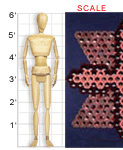VAM galleries including this work:
The Kentucky Library and Museum | Do You See a Pattern? || VAM Home
Margaret Younglove Calvert (Kentucky, 1829-1920)
TUMBLING BLOCKS (CROSS VARIATION) QUILT, 1850-1870
Piecework; 72" X 77"
4031
Kentucky Library and Museum, Western Kentucky University
This quilt is organized around the Baby Blocks pattern. It is significant both because of its visual beauty and because of its historical connection to the novel Aunt Jane of Kentucky.
The basic unit of the design is a hexagon divided into three diamonds. Individual blocks create a variety of optical effects, depending upon how the pieces are assembled. Common variations include Cubework, Disappearing Blocks, Golden Cubes, and Stair Steps. The Tumbling Blocks quilt uses Baby Blocks to create a cross that floats in front of a field that resembles an hourglass. The arrangement and contrast of light and dark quilt pieces create an amazing dimensional illusion. Quilt historian Jonathan Holstein has described Calvert’s use of color as “tough and painterly.”
About the Artist
Margaret Younglove Calvert, wife of Bowling Green lawyer Thomas Calvert (1826-1898) and mother of five children, is credited with making Tumbling Blocks. She may also have been the inspiration for the novel Aunt Jane of Kentucky, which her daughter Lida Calvert Obenchain (1856-1935) wrote under the pseudonym Eliza Calvert Hall. In the book, quilts help explain Aunt Jane’s philosophy of life; they represent history, autobiography, imagination, and memory—monuments to ordinary women’s lives and unheralded “women’s work.” A quilt also symbolizes the challenge of living and the role of faith. “The Lord sends us the pieces,” Aunt Jane observes, “but we can cut ’em out and put ’em together pretty much to suit ourselves.”
Classroom Ideas
Discussion: How has the artist created the illusion of three-dimensionality in this quilt? How is color used to make certain parts of the quilt stand out? What shapes are repeated in the quilt? What is the main focus of the quilt? What makes it the main focus?
Activity: Make your own 3D design pattern by drawing geometric shapes. Then color in your design.
Note: The Kentucky Library and Museum offers a “Quilting and Education Guide” that provides historical information and activities for students and teachers.
Links
Information about Eliza Calvert Hall and excerpts from her novel Aunt Jane of Kentucky can be seen on the Western Kentucky University web site. The pages also include a detail from the quilt.
[www.wku.edu/Library/onlinexh/lco/]
[www.wku.edu/Library/onlinexh/lco/quilt.htm]
You’ll find more links related to Aunt Jane, including a discussion of the book, on KET’s bookclub@ket site.
[www.ket.org/bookclub/books/2001_jun/]
Some sources of lesson plans on geometric quilt design:
- SEED—Spreading Educator to Educator Development (PDF file)
[seed.mainecenter.org/application/files/packets/PDF321.pdf] - QuiltArtz, the web site of Kentucky quilter Rebekka Seigel
[www.quiltartz.com/geometric_lp.html] - Geometry in Traditional Quilt Designs by Julie Curtis
[aam.wcu.edu/curtis/]


